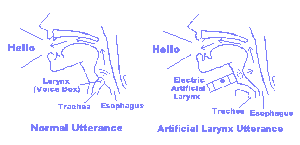Difference between revisions of "Electrolarynx"
(updated historical overview) |
(added pictures) |
||
| (2 intermediate revisions by the same user not shown) | |||
| Line 1: | Line 1: | ||
| + | [[File:EL usage.gif|thumbnail|right|The usage of an electrolarynx]] | ||
| + | [[File:Different ELs.jpg|thumbnail|right|Different brands of electrolarynxes]] | ||
<div style="float:right; clear:right;"> | <div style="float:right; clear:right;"> | ||
List of [[:Category:Electrolarynx|Electrolarynxes]]: | List of [[:Category:Electrolarynx|Electrolarynxes]]: | ||
| Line 6: | Line 8: | ||
order=ascending | order=ascending | ||
</DynamicPageList></div> | </DynamicPageList></div> | ||
| − | |||
| − | |||
Electrolarynxes are [[:Category:Speech_Technologies|Speech Technologies]] battery-powered devices that replace the sound-vibrating capabilities of the larynx and they usually resemble a small hand-held tube that the user operates with one hand. The device is put against the tissue of the throat or under the chin<ref>http://www.drshute.com/archives/2004/08/theres_nothing.html</ref> and the user engages the vibrator on the device. The vibrations the device generates are then carried over to the inside of the oral cavity. The user can then use the rest of the vocal tract to shape the sound and speak.<ref>LIU, Hanjun; NG, Manwa L. Electrolarynx in voice rehabilitation. Auris Nasus Larynx, 2007, 34.3: 327-332.</ref> | Electrolarynxes are [[:Category:Speech_Technologies|Speech Technologies]] battery-powered devices that replace the sound-vibrating capabilities of the larynx and they usually resemble a small hand-held tube that the user operates with one hand. The device is put against the tissue of the throat or under the chin<ref>http://www.drshute.com/archives/2004/08/theres_nothing.html</ref> and the user engages the vibrator on the device. The vibrations the device generates are then carried over to the inside of the oral cavity. The user can then use the rest of the vocal tract to shape the sound and speak.<ref>LIU, Hanjun; NG, Manwa L. Electrolarynx in voice rehabilitation. Auris Nasus Larynx, 2007, 34.3: 327-332.</ref> | ||
This allows people who have lost either a part or the entire larynx due to cancer to be able to produce speech and to communicate again. | This allows people who have lost either a part or the entire larynx due to cancer to be able to produce speech and to communicate again. | ||
| + | |||
| + | http://drtbalu.com/Voice_rehab.html | ||
== Historical overview == | == Historical overview == | ||
The current electrolarynxes are hand-held electromechanical devices that use a small vibrator to vibrate the inside of the oral cavity. But before miniaturization allowed such devices to be battery-powered and of portable size, pneumatic external larynxes were used. The first pneumatic artificial larynx was introduced by the Western Electric Company as the Western Electric No° 2 type larynx.<ref>Riesz R. Description and demonstration of an artificial larynx. Journal of the Acoustical Society of America 1929; 1: 273-9.</ref> It was available on the market from 1930 to 1959.<ref name="vandertorn">VAN DER TORN, Marein. A sound-producing voice prosthesis. Ph. D. Thesis. Amsterdam. VU Medical Center: VU Medical Center, 2005.</ref> | The current electrolarynxes are hand-held electromechanical devices that use a small vibrator to vibrate the inside of the oral cavity. But before miniaturization allowed such devices to be battery-powered and of portable size, pneumatic external larynxes were used. The first pneumatic artificial larynx was introduced by the Western Electric Company as the Western Electric No° 2 type larynx.<ref>Riesz R. Description and demonstration of an artificial larynx. Journal of the Acoustical Society of America 1929; 1: 273-9.</ref> It was available on the market from 1930 to 1959.<ref name="vandertorn">VAN DER TORN, Marein. A sound-producing voice prosthesis. Ph. D. Thesis. Amsterdam. VU Medical Center: VU Medical Center, 2005.</ref> | ||
| + | |||
| + | http://www.terapeak.com/worth/vintage-western-electric-no-5-type-electronic-artificial-larynx-nos-in-box/281101670442/ | ||
These devices were attached to the tracheostoma of the patient. The device was shaped in such a way that the exhaled air produced a humming noise. It was then carried via a small tube to the inside of the patient's mouth where it served as a base for speech much like the vibrations produced by a modern electrolarynx.<ref>http://www.cancer.gov/publications/dictionaries/cancer-terms?CdrID=46223</ref> TODO: Add picture of pneumatic larynx | These devices were attached to the tracheostoma of the patient. The device was shaped in such a way that the exhaled air produced a humming noise. It was then carried via a small tube to the inside of the patient's mouth where it served as a base for speech much like the vibrations produced by a modern electrolarynx.<ref>http://www.cancer.gov/publications/dictionaries/cancer-terms?CdrID=46223</ref> TODO: Add picture of pneumatic larynx | ||
Latest revision as of 13:54, 12 February 2016
Electrolarynxes are Speech Technologies battery-powered devices that replace the sound-vibrating capabilities of the larynx and they usually resemble a small hand-held tube that the user operates with one hand. The device is put against the tissue of the throat or under the chin[1] and the user engages the vibrator on the device. The vibrations the device generates are then carried over to the inside of the oral cavity. The user can then use the rest of the vocal tract to shape the sound and speak.[2]
This allows people who have lost either a part or the entire larynx due to cancer to be able to produce speech and to communicate again.
http://drtbalu.com/Voice_rehab.html
Contents
Historical overview
The current electrolarynxes are hand-held electromechanical devices that use a small vibrator to vibrate the inside of the oral cavity. But before miniaturization allowed such devices to be battery-powered and of portable size, pneumatic external larynxes were used. The first pneumatic artificial larynx was introduced by the Western Electric Company as the Western Electric No° 2 type larynx.[3] It was available on the market from 1930 to 1959.[4]
These devices were attached to the tracheostoma of the patient. The device was shaped in such a way that the exhaled air produced a humming noise. It was then carried via a small tube to the inside of the patient's mouth where it served as a base for speech much like the vibrations produced by a modern electrolarynx.[5] TODO: Add picture of pneumatic larynx
The first battery-powered electrolarynx was introduced by the company in 1942.
http://www.drshute.com/archives/2004/08/current_trends.html
UEMI, Norihiro, et al. Design of a new electrolarynx having a pitch control function. In: Robot and Human Communication, 1994. RO-MAN'94 Nagoya, Proceedings., 3rd IEEE International Workshop on. IEEE, 1994. p. 198-203.
LIU, Hanjun, et al. Enhancement of electrolarynx speech based on auditory masking. Biomedical Engineering, IEEE Transactions on, 2006, 53.5: 865-874.
Summary of technical aspects
Use
Relevant issues
Enhancement or treatment
Public and media impact
Public policy
References
- ↑ http://www.drshute.com/archives/2004/08/theres_nothing.html
- ↑ LIU, Hanjun; NG, Manwa L. Electrolarynx in voice rehabilitation. Auris Nasus Larynx, 2007, 34.3: 327-332.
- ↑ Riesz R. Description and demonstration of an artificial larynx. Journal of the Acoustical Society of America 1929; 1: 273-9.
- ↑ VAN DER TORN, Marein. A sound-producing voice prosthesis. Ph. D. Thesis. Amsterdam. VU Medical Center: VU Medical Center, 2005.
- ↑ http://www.cancer.gov/publications/dictionaries/cancer-terms?CdrID=46223

